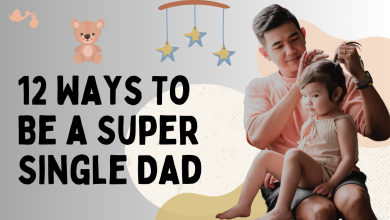No Prep Needed! 14+ Simple Games to Train Your Child’s Brain
Concentration games for children are more important than ever, especially in our time, because the high level of media consumption has a negative impact on the concentration skills of young children.
Even if we make sure that the television and radio in the household are not constantly on, there are still our smartphones, which are very attractive to children and which we now use quite unreflectively.
In addition to the noise level in daycare centers and schools, it is primarily these media that can turn out to be the cause of later lack of concentration.
Have you ever watched a child using a cell phone?
How it clicks from video to video, from content to content, without lingering on anything for long?
As a mother or perhaps as a teacher or childminder , have you noticed that preschool children are far too easily distracted and cannot stay with one game, one thing or one activity for long?
In this article, you will learn how to playfully promote the cognitive ability to concentrate with children and at what age this makes sense.
These games are also a great activity for the whole family .
Concentration games for children – What is concentration and when can you encourage it?
Concentration describes the ability to devote one’s full attention to a particular activity in order to solve a task or learn something.
Toddlers up to the age of five do not yet have this cognitive ability and are easily distracted because they perceive their environment quite unfiltered and cannot block out external stimuli.
The older they get, the easier it is for children to concentrate.
Over time, they learn to focus their attention on a process or task and not allow themselves to be distracted.
Educators know best that toddlers are still too young to focus and concentrate for long periods of time.
At the age of five to ten, you should not expect more than that the child concentrates on something for 15 minutes at a time.
That may sound like very little at first, but even as adults, the time we manage to maintain concentration is less than an hour. Then we definitely need a break.
Every child has a different attention span and must learn to concentrate at their own pace.
Good conditions for this are provided if you pay attention to a healthy diet and plenty of exercise outdoors.
A stimulating and loving environment is also important for the development of the ability to concentrate.
A lot of criticism, arguments, stress and anger disrupt attention enormously.
Especially when dealing with a group of children, it is best to ensure that they get enough exercise before playing concentration games so that the children can let off steam and get their energy flowing, making it easier for them to focus and develop patience.
Movement games with or without a competitive element are most useful outdoors.
Not only is there more space for games, but fresh air and ideally sunshine also help the children stay physically and mentally fit.
After all, sufficient exercise drives brain development.
Concentration games for children – What is beneficial even for the youngest
Certain games to promote concentration only make sense from preschool onwards, i.e. from the age of five.
Concentration games for kindergarten – This does not mean, however, that two- or three-year-olds are left out and have nothing to do with concentration exercises until then.
Even when stories are read aloud, the little ones need to concentrate to the highest degree.
Attentive listening is particularly challenging for young children. Hidden object books are also a great way to train concentration without the children even noticing.
These picture books with many details are very popular.
Even two- or three-year-olds often spend longer looking at pictures and enjoy new discoveries. You can even take advantage of this when preparing for your child’s second birthday or third anniversary by delighting your little one and their little friends with picture-books.
To provide variety, you can, for example, buy a poster-sized hidden object picture for small children and illuminate different areas with a flashlight.
The light directs the children’s focus and helps them block out the rest of the picture.
Or (for older children) you can increase the level of difficulty and briefly illuminate an area of the picture before quickly turning the flashlight off again.
The child should then indicate what was just illuminated.
Memory, which all children love, also trains concentration in addition to memory and attention.
You can take your child’s preferences into account and create your own memory set.
Or you can approach a theme with a specific memory set, such as different types of spring flowers, the four seasons, pets and wild animals, vehicles, etc.
During the game, the pictures are discussed and the child learns something along the way.
Have you ever heard of auditory memory? It’s inspired by the pedagogical approach of the famous Maria Montessori, who is also known for developing specific educational toys.
You can make an audio memory game yourself quite quickly and easily. Collect the capsules from Kinder Surprise eggs (other containers like film canisters or bottles will also work, of course).
There should be about twelve to twenty pieces.
You then fill these containers with things you have around the house, such as rice, flour, peas, paper clips, tea, sugar, salt, pepper and other spices, etc.
The same amount goes into each pair of containers, so that you end up with pairs of containers that sound the same when shaken.
The little ones especially have fun with them! But please be careful that children don’t swallow anything if the containers can’t be closed tightly.
Counting can also be made into a game for small children, for example by counting the steps in the hallway or in the shopping center.
As a rule, teachers also have the youngest children in the group counted and those who are absent named.
This requires a high level of concentration and is something children enjoy doing, especially when they are just learning to count.
By the way, did you know that getting dressed and undressed independently can also be considered a concentration exercise?
This may sound strange, but two-year-olds are still internalizing the processes.
So you put on your jacket and shoes first and then your gloves.
Until these processes are burned into long-term memory, it still requires special concentration to dress or undress properly.
14 memory and concentration games for children that require little or no material
Children’s games designed to promote concentration should, above all, be fun. The greater children’s interest in the games, the greater their attention span.
There are games that are almost always a hit. Some require sitting still, while others require movement and motor coordination.
I’ll introduce them here. Among them are brain teasers that are great for entertaining in between, such as during car rides, in restaurants, or on walks.
Some of the games are suitable for preschool children, while others are more challenging and can be played from primary school onwards.
1. I pack my suitcase
This game, very popular among children, is recommended for ages six and up and trains memory and memorization skills. It’s suitable as a family game, as adults can also join in.
For the game, imagine that a suitcase is being packed.
To support the imagination, you can use an object that is then passed back and forth or to someone else.
Someone starts with the sentence:
I pack my suitcase… and take a shirt with me.
The next player should now repeat this sentence and add something else:
I pack my suitcase and take a shirt and a blouse with me.
If several children are involved, the game continues until someone can no longer repeat all the items in order. That child is eliminated.
The winner is the person who can list the most items, ideally in the correct order.
The game also works well with just a few participants; for example, it can be played by a mother, father, and child without anyone having to drop out.
Instead, if you make a mistake, you can simply start all over again.
By the way, did you know that children in daycare can usually only remember two or three words? Therefore, the game isn’t really suitable for kindergarten.
Every two years or so, children can remember one more word, but the limit is soon reached: even adults can’t remember more than seven words on average.
2. Listening and counting
This is also a game that, as an acoustic concentration exercise, requires you to be quiet and calm.
So it’s best to play with your child after they’ve been to the playground or had a good time somewhere else.
Children aged five and above are given the task of listening attentively when a book is read aloud or a radio play is played and counting certain words that they hear.
The possibilities are endless, but it makes sense to choose a word that occurs frequently, such as “and”, “I”, “was”, “one”, etc.
The task itself requires a high level of concentration.
The level of difficulty can be increased if the child has to pay attention to several words at once and count how often they occur.
Of course, you should never expect the children to be able to repeat the content of the story later.
It is best to play with a story that is very well known so that they do not prefer to follow the content out of curiosity.
3. No yes or no
This uncomplicated game can be played at any time and, with children aged six and over, can help develop concentration, memory, and language skills.
The game works great with just two players, one who asks questions and one who answers.
A round of play shouldn’t take too long. Two minutes is perfectly sufficient.
You can be the one who asks your child questions, questions to which they would automatically answer with “yes” or “no.”
But it shouldn’t, because “yes” and “no” are forbidden as answers.
This requires some thought. Examples of questions might include: Would you like to be a werewolf? Are you afraid of water? Have you ever climbed a tree? Is chocolate your favorite snack? Etc.
Depending on the child’s age, they can use the words used in the question to answer, or you can make the game more difficult and set the rule that they must not only avoid “yes” and “no” but also answer in other words, such as:
Would you like to be a werewolf? Answer: I don’t like monsters. Question: Are you afraid of water ? Answer: I love swimming . Question: Have you ever climbed a tree? Answer: I’ve observed the world from a treetop. Question: Is chocolate your favorite snack? Answer: I love to eat muffins between meals.
Otherwise, your child can, of course, repeat your choice of words. Pay attention to how they use prepositions and cases.
In any case, the round is over when either a certain amount of time has passed (for example, one to two minutes) or the answer is accidentally “yes” or “no”.
4. Reverse alphabet
From age seven, you can try the alphabet from the back if you’re looking for a challenge. Of course, you can also try the concentration game from age six.
However, even most adults have to admit: reciting the ABC backwards is not easy at all!
Alternatively, you can skip every second or third letter when reciting the ABC.
Or every fifth or tenth. Numerous variations are possible, including skipping letters while reciting the alphabet backward.
Also suitable as an activity for school children on the go.
5. Alphabet of Animals
The alphabet also plays a major role in this memory game for children aged six and up.
It’s most fun when there are several players.
So why not get the whole family involved at the next get-together to encourage the children to remember?
And it’s this simple: For each letter of the alphabet, an animal beginning with the corresponding letter is named. Everyone has to be careful not to repeat the animal named.
The round starts with the letter A and someone naming the first animal, for example “monkey”.
The next person must now name another animal with “A”, such as “ant”.
Only when no one can think of another animal starting with “A” do you move on to the next letter in the alphabet.
It can take quite a while to find the corresponding animals for each letter of the alphabet!
You could also write down all the animals to have a nice overview of the diverse animal kingdom. A great learning game for all ages!
6. Trace
This exercise requires concentration and observation skills and can be fun for children as young as six years old.
If mom or dad takes the initiative and shows how they do it, the child will be more motivated to try it.
You choose an object and observe it intensively for a certain period of time, trying to memorize everything as best as possible.
Then you draw it on a piece of paper, in as much detail as possible.
7. Cloud pictures
We all know this game, which is no pastime for dreamers. For children ages six and up, it promotes spatial thinking and creativity.
When the weather is nice, you lie in the garden with your child or sit on a bench in the park and watch the clouds.
Of course, the best ideas come from particularly fluffy clouds.
In the afternoon after a busy day at school, the child will certainly look forward to creative play and can also relax at the same time.
In order to promote concentration when observing clouds, one not only tries to recognize as many animals and figures in the sky as possible.
Then you close your eyes for a few seconds and try to find the cloud that inspired you.
Of course, you can also just look out the window for this game. However, unless it’s raining, it’s better to get some fresh air.
8. Rhythmic stop game
This game is best played with several kindergarten-age children, as it then becomes competitive and encourages the children to concentrate even better.
You can also consider introducing a reward for your child at home if they make an effort.
A drum would be nice, but a pot and a wooden spoon are also enough to promote children’s motor concentration with this game.
It may seem simple, but it is only from the age of five that children are able to concentrate on following the rules.
You set the beat, and the child has to follow the steps. At some point, you stop the rhythm. Then the child is also supposed to stand still.
If the player doesn’t manage to do this before a beat starts again, the game is over or the player is eliminated from the round.
If you want to play with younger children, you should not introduce too many variations and keep the same rhythm if possible.
Otherwise, for slightly older children, you can increase the level of difficulty by varying the game.
9. Schuhplattler
Actually a dance from the Eastern Alps that developed from the Ländler, the Schuhplattler can also be used as a movement game for children from the age of seven to promote motor coordination and concentration.
Children get moving, which can be accompanied by music. Stand with your feet hip-width apart.
Depending on whether you give a signal or wait for the appropriate rhythm, you lift your right leg and touch your right heel with your left hand. Then you return to the starting position.
Next, it’s the other side’s turn. In between, you can also introduce other movements, such as clapping your hands.
But even so, the child still needs to concentrate hard to perform the correct movements. Of course, the faster they have to run, the more difficult it becomes.
10. Children’s yoga
Of course it has to do with movement, but it is not suitable for letting off steam: There are also physical exercises for children that are called asanas in yoga.
Yoga has been proven to have a healthy effect on the body and mind and can also promote concentration.
Whether it’s exercises like cat-cow, warrior pose, or sun salutation as a sequence of several exercises, children from the age of six quickly realize that it’s not that easy to coordinate breathing with movements.
Ultimately, you have to be fully focused on it.
Yoga is of course not a game, but some exercises are great for promoting concentration and balance in a playful way, such as the tree pose.
The child stands with his legs hip-width apart and looks for a point on the opposite wall that he can focus his gaze on.
While inhaling, lift one foot and rest it against the ankle, knee, or thigh of the other leg, so that the knee points to the side.
As the child exhales, he brings his hands together in front of his chest as if in prayer.
The person remains in this position for a few conscious breaths until they feel secure enough to stretch their hands upwards while inhaling again and remain in this position for a few more breaths.
It sounds simple, but it takes a lot of concentration to get the tree right. The feeling of success is all the more rewarding!
11. Finger tapping
As a combination of memory training and exercise, this game is quite challenging for children aged six and up, as it requires both concentration and coordination skills.
Each finger of the hand is assigned a number. You can start simply by giving the thumb the number one, then the index finger the number two, the middle finger the number three, and so on.
You think of a numerical code and write it down.
Since the child will be tapping it out on the table with their fingers, it should be well thought out and not be impossible. So it’s best to try it out yourself first.
If the child has mastered the exercise so well that the number code is no longer a challenge, the second hand can be used, for example, and the number code can be expanded from 5 to 10.
You can also say the code at different speeds and vary the level of difficulty in this way.
12. Clapping game
For children aged five and over, this active game not only promotes concentration but also language skills, coordination, and a sense of rhythm, and it also helps shy children to come out of their shells.
Even the youngest children love clapping games. It’s no wonder, since they’re fun and combine language, movement, rhythm, and often singing.
In this game, you stand opposite your child and teach him the following saying:
We clap our hands,
we slap our bottoms,
we clap our shoulders,
we just clap.
Once the child has memorized the saying well, you should coordinate the words, rhythm, and clapping together, for example like this:
at We are slapped on the thighs
at klat – hands are clapped
at – schen the hands are clapping again
at in is clapped on the shoulders
at which the knees are slapped
at Hän – hands are clapped
at – de the hands are clapping
Of course, you can vary the movements and make them easier or more difficult. You can also repeat the phrase several times.
13. The Water Glass Game
This is another quiet game that requires children aged six and over to focus on a specific point.
In addition to concentration, motor skills and coordination are also practiced.
The child is given a clear glass filled with some water. It shouldn’t be filled to the brim, but rather about half full; that’s perfectly sufficient.
Now the child stretches out the arm with the hand in which he is holding the glass of water and should keep it stretched out for as long as possible.
However, the water in the glass must not move, otherwise the game is over.
As you might imagine, the game is usually short-lived, but children happily accept the challenge and focus all their attention on the water surface.
14. Rubber twist
This movement game encourages coordination of motor skills and language and is enjoyed by children aged five and over, especially girls.
All you need is a rubber band about three or four meters long, with the ends knotted together.
Only three children can play at a time. Two stand opposite each other and spread the rubber band between them by stepping inside and stretching it apart.
First, the elastic bands go around the ankles, then around the backs of the knees, and finally around the hips, increasing the difficulty level.
The third child is the jumper and stands so that there is a rubber band between their feet.
The jumper should not jump over the rubber band, but rather jump up on a signal, but without stepping on the rubber band. The signal is the word “rubber” in these verses:
On a rubber – rubber – mountain
lives a rubber – rubber – dwarf
scratches his rubber – rubber – head
ties the rubber band
drinks from the rubber – rubber – jug
waves from the rubber – rubber – train
bites into the rubber – rubber – bread
and waits for the rubber – sunset
Concentration games for children ‒ board games & co.
Even in our age of computer games, board and parlor games are still popular and are generally more than just a pastime for children.
Depending on the game, different skills are addressed and promoted, such as coordination and dexterity, language skills, social skills (e.g. following the rules), creativity, strategic and logical thinking, etc.
“Domino” is a classic tile-laying game that even three-year-olds can play. After all, the tiles come not only with numbers, but also with pictures.
And the rules of the game are very simple: You have to place your own pieces as quickly as possible so that the numbers or pictures match.
The logic game “Connect Four” from the 70s is also suitable for children aged six and over and for two players.
It is played with a hollow game board, because you have to manage to place four pieces of your own color in a row.
You also have to watch your opponent’s moves to prevent him or her from doing it first, which also makes it a strategy game.
“Jenga” has also found its way into many households as a game of skill and can be played by a primary school child alone, but up to ten players are also possible.
Little by little, individual wooden blocks are pulled out of the wobbly tower and placed on top until the tower eventually collapses.
How can poor concentration be helped?
First of all: Parents very often have unrealistic expectations of their children, as noted by Cologne psychology professor Gerhard Lauth, who works with children.
But educational specialists and teachers also overestimate the number of children who allegedly suffer from ADHD.
In fact, attention disorders are much less common, while adults simply expect too much discipline from children for various reasons.
For example, the youngest children in daycare often have to learn to concentrate in a loud environment, while school children are often overwhelmed by the many demands that are placed on them.
In order for the nerve cells to connect and the neural pathways to be laid for the cognitive ability to concentrate, a calm and stress-free atmosphere is primarily beneficial.
However, this isn’t always the case in daycare and school. So it’s no wonder that children are distracted by the sounds and conversations of others, as well as by noise.
In addition, sufficient sleep is still of crucial importance for development, especially in children.
As a rule, changes in sleeping habits occur at the latest when children start school.
For example, the child must break the habit of taking a nap in the afternoon , even if it is only postponed until the afternoon.
You also need energy to be able to concentrate. This is achieved not only through sufficient sleep but also through a healthy and balanced diet.
Unfortunately, it is not common practice in all families to pay attention to this, which can also be noticeable as obesity in childhood .
If breaks are too short and children don’t get enough rest, this quickly leads to a lack of energy. Conversely, children can also be bursting with energy and unable to sit still.
The urge to move should definitely be satisfied before you expect children to pay attention.
A stress-free and calm atmosphere, proper sleeping habits and enough breaks (even if it is boring at times), sufficient exercise and a healthy diet are the factors that have a positive effect on learning to concentrate.
These must be present, otherwise no amount of concentration training can really help. In general, children’s lives shouldn’t constantly revolve around optimal development.
Children should simply be allowed to be children and this must be accepted because, depending on their age, they cannot concentrate for longer than ten or twenty minutes.
With all the concentration games mentioned, it should be noted that parents should be good role models.
Whether it’s doing a puzzle, playing memory, reciting the alphabet backwards or playing board games, parents should stay on task and not check their cell phone or do something similar.
Ideally, all the exercises and games should be integrated into everyday life in such a way that the child does not get the feeling that he or she is being trained.
Furthermore, children should of course primarily pursue activities that interest them and that they enjoy.
Positive feedback from parents and educational professionals also has a positive effect on children’s motivation to stick with something and learn.
Fortunately, inattentive behavior in children does not automatically mean that therapy is needed.
Attention and concentration disorders usually manifest themselves in the child behaving abnormally on several fronts over a longer period of time, i.e. in interactions with peers, at home and in daycare or school.
So if the teacher or educator mentions the inattentive behavior that you have also observed in your child for a long time, it is advisable to consult a pediatrician who specializes in ADHD.
Final thoughts
Due to developmental reasons, children cannot concentrate for very long periods of time. The average is about 15 minutes for five- to seven-year-olds.
But even at the age of seven to ten, children can rarely concentrate for longer than 20 minutes, between ten and twelve years about 25 minutes, and up to the age of 16 about half an hour.
In fact, parents, educational professionals, and teachers are often wrong in their estimates of the number of children with attention disorders.
Concentration has to be learned and, as with everything else, the influencing factors are of essential importance.
A healthy diet, plenty of exercise, little stress, plenty of rest and sufficient sleep are necessary for optimal concentration.
However, school and training can only be done in moderation and it is important that the exercises and games are primarily fun and arouse the interest of the children.
It is best to integrate them into everyday life in such a way that the children do not even notice that they are exercises.
In this article I have mentioned various concentration games in which you have to be still or move.
In addition to concentration, memory and motor skills are often also promoted. Many of the games mentioned are great for playing on the go or in between other activities, and can also be used as games for getting to know each other at school .
For very young children, i.e. one- and two-year-olds, certain exercises do not yet make sense.
However, they already learn to concentrate by looking at picture books and hidden object books, by listening attentively to songs and even by dressing and undressing themselves.
In any case, despite the increasing demands on children, which are particularly significant at school, one should not drive oneself crazy and simply let children be children.







